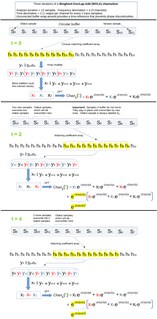
Chrominance is the signal used in video systems to convey the color information of the picture, separately from the accompanying luma signal. Chrominance is usually represented as two color-difference components: U = B′ − Y′ (blue − luma) and V = R′ − Y′ (red − luma). Each of these difference components may have scale factors and offsets applied to it, as specified by the applicable video standard.
Digital signal processing (DSP) is the use of digital processing, such as by computers or more specialized digital signal processors, to perform a wide variety of signal processing operations. The digital signals processed in this manner are a sequence of numbers that represent samples of a continuous variable in a domain such as time, space, or frequency. In digital electronics, a digital signal is represented as a pulse train, which is typically generated by the switching of a transistor.

The Nyquist–Shannon sampling theorem is a theorem in the field of signal processing which serves as a fundamental bridge between continuous-time signals and discrete-time signals. It establishes a sufficient condition for a sample rate that permits a discrete sequence of samples to capture all the information from a continuous-time signal of finite bandwidth.

In signal processing, the Nyquist rate, named after Harry Nyquist, specifies a sampling rate. In units of samples per second its value is twice the highest frequency (bandwidth) in Hz of a function or signal to be sampled. With an equal or higher sampling rate, the resulting discrete-time sequence is said to be free of the distortion known as aliasing. Conversely, for a given sample rate, the corresponding Nyquist frequency in Hz is the largest bandwidth that can be sampled without aliasing, and its value is one-half the sample-rate. Note that the Nyquist rate is a property of a continuous-time signal, whereas Nyquist frequency is a property of a discrete-time system.
Time stretching is the process of changing the speed or duration of an audio signal without affecting its pitch. Pitch scaling is the opposite: the process of changing the pitch without affecting the speed. Pitch shift is pitch scaling implemented in an effects unit and intended for live performance. Pitch control is a simpler process which affects pitch and speed simultaneously by slowing down or speeding up a recording.
In digital signal processing, spatial anti-aliasing is a technique for minimizing the distortion artifacts known as aliasing when representing a high-resolution image at a lower resolution. Anti-aliasing is used in digital photography, computer graphics, digital audio, and many other applications.

In signal processing and related disciplines, aliasing is an effect that causes different signals to become indistinguishable when sampled. It also often refers to the distortion or artifact that results when a signal reconstructed from samples is different from the original continuous signal.

In signal processing, the Nyquist frequency, named after Harry Nyquist, is a characteristic of a sampler, which converts a continuous function or signal into a discrete sequence. In units of cycles per second (Hz), its value is one-half of the sampling rate. When the highest frequency (bandwidth) of a signal is less than the Nyquist frequency of the sampler, the resulting discrete-time sequence is said to be free of the distortion known as aliasing, and the corresponding sample-rate is said to be above the Nyquist rate for that particular signal.
Chroma subsampling is the practice of encoding images by implementing less resolution for chroma information than for luma information, taking advantage of the human visual system's lower acuity for color differences than for luminance.

In signal processing, sampling is the reduction of a continuous-time signal to a discrete-time signal. A common example is the conversion of a sound wave to a sequence of samples.
Coherence, coherency, or coherent may refer to the following:

A spectrum analyzer measures the magnitude of an input signal versus frequency within the full frequency range of the instrument. The primary use is to measure the power of the spectrum of known and unknown signals. The input signal that most common spectrum analyzers measure is electrical; however, spectral compositions of other signals, such as acoustic pressure waves and optical light waves, can be considered through the use of an appropriate transducer. Spectrum analyzers for other types of signals also exist, such as optical spectrum analyzers which use direct optical techniques such as a monochromator to make measurements.

In signal processing, undersampling or bandpass sampling is a technique where one samples a bandpass-filtered signal at a sample rate below its Nyquist rate, but is still able to reconstruct the signal.
Normalization or normalisation refers to a process that makes something more normal or regular. Most commonly it refers to:

In signal processing, a filter bank is an array of bandpass filters that separates the input signal into multiple components, each one carrying a single frequency sub-band of the original signal. One application of a filter bank is a graphic equalizer, which can attenuate the components differently and recombine them into a modified version of the original signal. The process of decomposition performed by the filter bank is called analysis ; the output of analysis is referred to as a subband signal with as many subbands as there are filters in the filter bank. The reconstruction process is called synthesis, meaning reconstitution of a complete signal resulting from the filtering process.
MUSE was an analog high-definition television system, using dot-interlacing and digital video compression to deliver 1125-line (1920x1035) high definition video signals to the home. Japan had the earliest working HDTV system, MUSE, which was named Hi-Vision with design efforts going back to 1979. The country began broadcasting wideband analog HDTV signals in 1989 using 1035 active lines interlaced in the standard 2:1 ratio (1035i) with 1125 lines total. By the time of its commercial launch in 1991, digital HDTV was already under development in the United States. Hi-Vision continued broadcasting in analog until 2007.
Television standards conversion is the process of changing a television transmission or recording from one television system to another. The most common is from NTSC to PAL or the other way around. This is done so television programs in one nation may be viewed in a nation with a different standard. The video is fed through a video standards converter, which makes a copy in a different video system.

In signal processing, sub-band coding (SBC) is any form of transform coding that breaks a signal into a number of different frequency bands, typically by using a fast Fourier transform, and encodes each one independently. This decomposition is often the first step in data compression for audio and video signals.
Multidimensional Digital Pre-distortion (MDDPD), often referred to as multiband digital pre-distortion (MBDPD), is a subset of digital predistortion (DPD) that enables DPD to be applied to signals (channels) that cannot or do not pass through the same digital pre-distorter but do concurrently pass through the same nonlinear system. Its ability to do so comes from the portion of multidimensional signal theory that deals with one dimensional discrete time vector input - 1-D discrete time vector output systems as defined in Multidimensional Digital Signal Processing. The first paper in which it found application was in 1991 as seen here. None of the applications of MDDPD are able to make use of the linear shift invariant (LSI) system properties as by definition they are nonlinear and not shift-invariant although they are often approximated as shift-invariant (memoryless).








